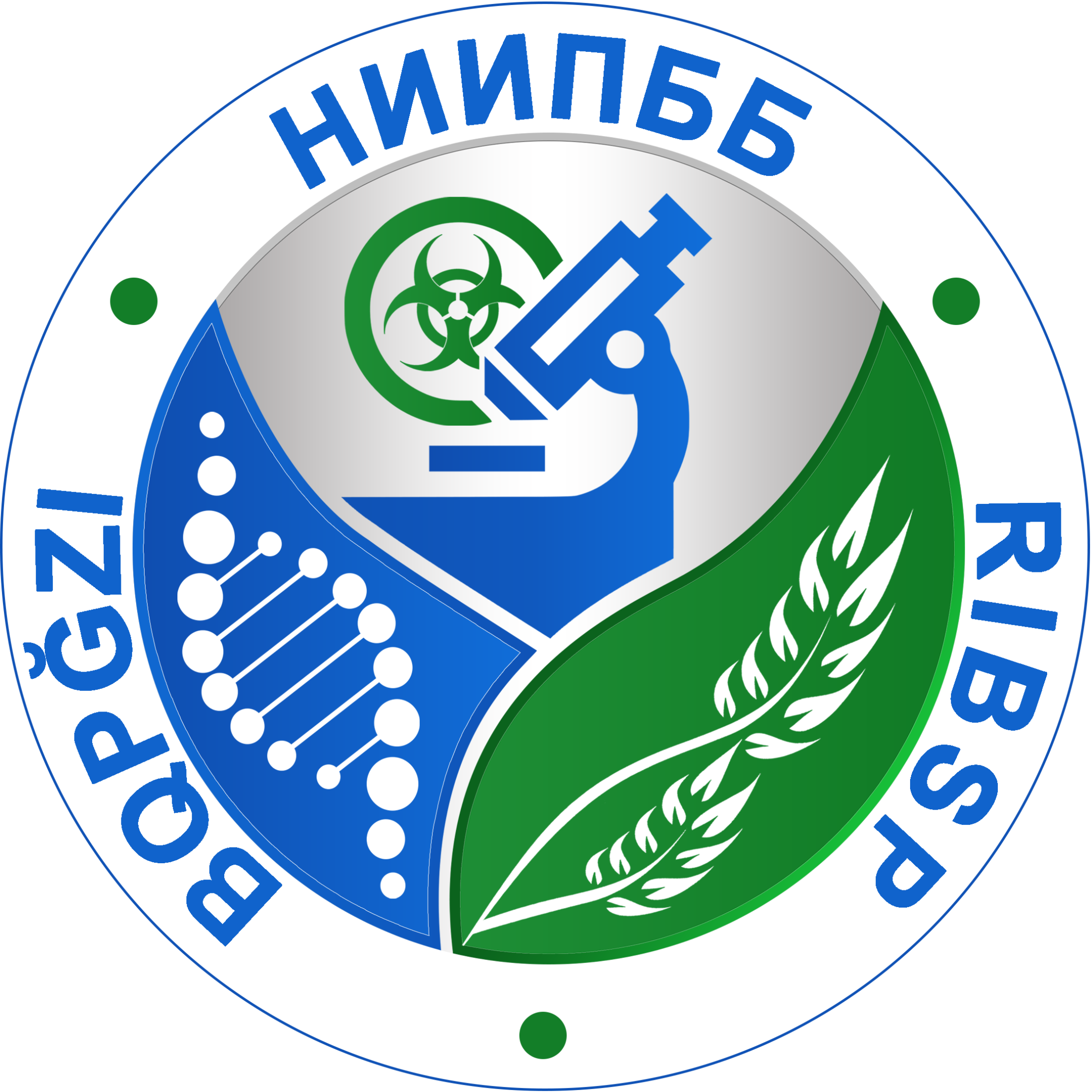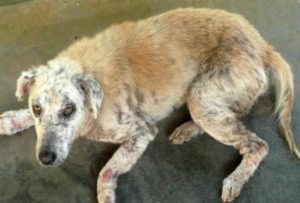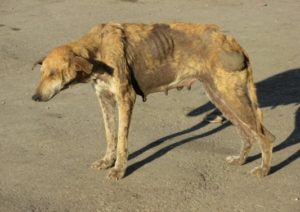For consultation, call the RSE “Research Institute for Biological Safety Problems” of SC MES RK by phone (726-36) 7-22-28.
E-mail: ribsp@biosafety.kz
For consultation, call: Bulatov Yerbol Akenovich, head of the laboratory “Technology of cultivation of microorganisms”, candidate of veterinary sciences, tel. +7 (701) -449-55-52
Concerning the acquisition of the vaccine: Ershebulov Zakir Dzhaparovich, Head of the Quality Department, tel. +7 (778) -881-46-83
Carnivorous animal can be a source of rabies disease
(Illustrative photo from open resourses)
Rabies (Rabies, hydrophobia Lyssa,) – a viral disease characterized by severe damage to the peripheral nervous system, signs of disseminated encephalomyelitis. A disease will inevitably be fatal. It refers to natural focal, periodic viral diseases. Infection affects all types of warm-blooded, domestic, farm animals, as well as most species of birds and humans. Young animals are more susceptible to the virus than old ones. Mortality in rabies is 100%. The economic damage is great, which consists of losses resulting from the death of animals, the costs of quarantine and preventive measures, the capture of stray dogs and cats, the regulation of the number of wild predators, as well as conducting diagnostic tests. The maximum increase in incidence in the fall and in the winter-spring period. Three-four-year cyclicity of rabies was established, which is associated with the dynamics of the abundance of main reservoirs.
Domestic carnivores can also be a source of rabies disease.
(Illustrative photo from open resourses)
Epizootology. Main epizootologic data of rabies:
Sources and reservoirs of the causative agent of infection. The reservoir and the main sources of the causative agent of rabies are wild predators, dogs and cats, and in some countries of the world – bats. Given the nature of the reservoir of the pathogen, epizootics are distinguished as of the natural type when wild carnivores (fox, raccoon dog, arctic fox, wolf, corsac, jackal) spread the disease, and urban type when stray dogs and cats are the source of the virus and the spread of the disease.
The method of infection and the mechanism of pathogen transmission. Infection of animals and humans occurs through direct contact with sources of the causative agent of rabies as a result of a bite or saliva of damaged skin or mucous membranes. Infection with rabies is possible through the mucous membranes of the eyes and nose, in alimentary and aerogenic, as well as transmissible ways.
The intensity of the manifestation of the epizootic process. With a high abundance of foxes, corsacs, raccoon dogs, wolves, jackals, arctic foxes, the disease spreads rapidly, with an average abundance rabies manifests itself only in rare cases. With a low population density of wild carnivorous epizootics remisses.
The course and clinical manifestation of rabies symptoms. The incubation period varies from several days to 1 year and averages 3-6 weeks. Its duration depends on the type, age, resistance of the animal, the amount of virus that has penetrated and its virulence, the location and the nature of the wound. The closer the wound to the brain, the faster the rabies clinic appears.
The disease is more acute. The clinical picture is similar in animals of all species, but better studied in dogs. Rabies in them usually manifests itself in two forms: furious and sullen. The recurrent and abortive course of the disease is recorded.
In furious rabies, three stages are distinguished: prodromal, excitative, and paralytic.
The prodromal period (stage of signs and symptoms) lasts from 12 hours to 3 days. This period begins with a slight change in behavior. Sick animals become apathetic, boring, avoid people, try to hide in a dark place, reluctantly go to the call of the owner. In other cases, the dog becomes affectionate to the owner and acquaintances, trying to lick his hands and face. Then anxiety and excitability gradually increase. The animal often lays down and jumps up, barks for no reason, there is an increased reflex excitability (to light, noise, rustling, touch, etc.), shortness of breath appears, the pupils are dilated. Sometimes a severe itching occurs at the site of the bite, the animal licks, combs, and nibbles it. With the progression of the disease, a perverted appetite often appears. The dog eats inedible objects (stones, glass, wood, earth, its own feces, etc.). During this period, paresis of the muscles of the pharynx develops. Difficult swallowing (it seems that the dog choked on something), salivation, hoarse and abrupt barking, hesitant gait, sometimes squint are noted.
Clinical presentation of canine rabies
(Illustrative photo from open resourses)
The second – excitative period – lasts 3-4 days and is characterized by an increase in the symptoms described above. Aggressiveness builds up, a dog for no reason can bite another animal or person, even its owner, gnaws on iron, sticks, earth, often breaking teeth, and sometimes the lower jaw. In sick dogs, the desire to break the chain and run away intensifies, a rabid dog runs tens of kilometers per day, bites and infects other dogs and people along the way. It is characteristic that the dog runs silently to animals and people and bites them. Attacks of violence lasting several hours are replaced by periods of oppression. Paralysis of individual muscle groups gradually develops. The change in the dog’s voice is especially noticeable due to paralysis of the muscles of the larynx. Lai sounds hoarse, resembling a howl. This symptom has diagnostic value. The lower jaw is completely paralyzed, it sags. The oral cavity is open all the time, the tongue half falls out, there is abundant salivation. At the same time, paralysis of the swallowing muscles and muscles of the tongue occurs, as a result of which the animals cannot eat food. Strabismus appears.
Clinical presentation of canine rabies
(Illustrative photo from open resourses)
The third – paralytic period – lasts 1-4 days. In addition to paralysis of the lower jaw, the hind limbs, the muscles of the tail, bladder and rectum, then the muscles of the trunk and forelimbs are paralyzed. The body temperature in the stage of excitation rises to 40-41 °C, and in the paralytic – decreases below normal. In the blood, polymorphic nuclear leukocytosis is noted, the number of leukocytes is reduced, the sugar content in urine is increased to 3%. The total duration of the disease is 8-10 days, but often death can occur in 3-4 days.
Clinical presentation of canine rabies
(Illustrative photo from open resourses)
With a sullen (paralytic) form of rabies (most often observed when dogs are infected from foxes), excitation is slight or not expressed at all. The animal is not aggressive, the appetite is preserved, there may be difficulty swallowing, similar to the condition when animals choke on the bone. There is paralysis of the pharynx, lower jaw, hind limbs. An unstable gait can be observed in a sick dog, sometimes with an atypical form the animal eats completely inedible objects, salivation develops. The disease lasts 2-4 days.
Clinical presentation of canine rabies
(Illustrative photo from open resourses)
The recurrent form of rabies is characterized by complete recovery, which after two to three weeks is again replaced by all the symptoms of the disease.
The abortive form of rabies ends with the recovery of the animal in the second stage of the disease. This form of rabies is very rare and is still being studied by many researchers.
The atypical form of rabies has no stage of excitation. Depletion and muscle atrophy are noted. There have been reported cases of rabies, which occurred only in cases of hemorrhagic gastroenteritis: vomiting, semi-liquid feces containing blood-mucous masses.
Clinical presentation of canine rabies
(Illustrative photo from open resourses)
With rabies in cats, the clinical signs are basically the same as in dogs, the disease proceeds mainly in a furious form. Often, an infected animal tries to hide in a quiet, dark place. Sick cats are very aggressive towards humans and dogs. They inflict deep damage by sticking their claws, trying to bite in the face. Their voice is changing. In the stage of excitement, cats tend, like dogs, to run away from home. In the future, paralysis of the pharynx and limbs develops. Death occurs 2-5 days after the manifestation of clinical signs. With paralytic rabies, aggressiveness is weak.
Clinical presentation of rabid cats
(Illustrative photo from open resourses)
With cattle rabies, the incubation period is more than 2 months, usually from 15 to 24 days. In some cases, it may take 1-3 years from the moment of the bite until the first signs of the disease appear. Rabies occurs mainly in two forms: furious and sullen.
With a furious form, the disease begins with excitement. The animal often lies down, jumps up, lashes its tail, stomps, rushes to the wall, strikes with horns. Aggressiveness is especially pronounced towards dogs and cats. Salivation, sweating, frequent urges to urination and defecation, rut are noted. After 2-3 days, paralysis of the muscles of the pharynx (inability to swallow), lower jaw (salivation), hind and forelimbs develop. Death occurs on the 3rd-6th day of illness,.
With a sullen form, signs of excitement are weak or absent. Depression is observed, cows go off feed. Cows ablactate and stop to ruminate. Then the paralysis of the larynx, pharynx, lower jaw (hoarse mooing, salivation, inability to swallow), and then the hind and front limbs appears. Death occurs on the 2nd-4th day.
Rabid cattle
(Illustrative photo from open resourses)
In sheep and goats, the symptoms are the same as in cattle: aggressiveness, especially to dogs, increased sexual arousal. Paralysis quickly develops, and on the 3-5th day the animals die. With a paralytic form of rabies, excitement and aggressiveness are not noted.
Clinical presentation of rabies of овец и коз
(Illustrative photo from open resourses)
Rabies in horses is initially manifested by anxiety, shyness, excitability. Itching is often possible at the site of the bite. Aggression to animals, and sometimes to people. During the period of excitement, horses rush to the wall, break their heads, gnaw at feeding troughs, doors, sometimes, on the contrary, fall into a state of depression, resting their head against the wall. Cramps in the muscles of the lips, cheeks, neck, and chest are noted. With the further progress of the disease, paralysis of the swallowing muscles and then the limbs develop. The animal dies on the 3-4th day of illness. But sometimes a fatal outcome occurs within 1 day. With a paralytic form of rabies, the stage of excitation does not occur.
Clinical presentation of rabies of horses
(Illustrative photo from open resourses)
Rabies in pigs is often acute and furious. Pigs rush about in pens, go off feed, gnaw feeders, partitions, the bite site. Strong salivation. Aggression is shown to other animals and people. Sows attack their own piglets. Soon paralysis develops, and 1-2 days after their appearance, the animals die. The duration of the disease is not more than 6 days.
In the paralytic form of rabies (rarely recorded), depression, going off feed and water, slight salivation, constipation, rapidly progressing paralysis are noted. Animals die 5 … 6 days after the manifestation of signs of the disease.
Rabid pigs
(Illustrative photo from open resourses)
Camels rabies manifests itself in a sullen or furious form, and death occurs 4-5 days after the clinical manifestation. The incubation period for rabies of camels is up to 1.5 months.
Clinical presentation of rabies of camels
(Illustrative photo from open resourses)
Diagnostics. The most accurate diagnostic results are achieved by examining several parts of the brain at once: the brainstem, cerebellum, cerebral cortex and horn of Ammon. The diagnosis of rabies based on the clinical picture is not possible, as the symptoms are similar to some other diseases. Diagnostics using histological changes (detection of Negri bodies), as well as DPR (diffuse precipitation reaction) is not currently used due to low sensitivity. Moreover, histological examination is not recommended for use by the OIE diagnostic and vaccine guidelines. IHCM (immunohistochemical method) is usually not used in diagnostics due to the complexity and duration of the reaction. In the diagnosis of rabies in tissue samples, RV proteins or fragments of its genome are detected. For this, RIF, virus isolation in animals (on mice) and in cell cultures, ELISA, PCR (polymerase chain reaction) and many others are used..
Specific prevention of agricultural, domestic animals. Vaccination of animals is one of the main effective ways to prevent rabies. For vaccination of farm and domestic animals, it is recommended to use the animal rabies inactivated vaccine from the strain “VRC-RZ2” of fixed rabies virus (developer – RIBSP). The vaccine is intended for prophylactic and compulsory immunization against rabies in cattle and small cattle, horses, camels, pigs, dogs and cats.
ANIMAL RABIES INACTIVATED VACCINE (DEVELOPER – RIBSP)
During prophylactic immunization of farm animals, the vaccine is administered subcutaneously in the middle third of the neck or croup (for pigs, intramuscularly behind the ear). Preventive immunization of dogs, cats and other carnivores is carried out subcutaneously or intramuscularly from two months of age. Preventive immunization is carried out once with subsequent revaccination in a year. For animals previously vaccinated against rabies, the vaccine is administered subcutaneously once every two years.
Preventive immunization of animals is carried out in the doses indicated in the table.
| Animal species | Age | Dose, ml |
| Horses and camels | Over 3 years old
from 3 months to 3 years |
10,0
5,0 |
| Cattle | Over 2 years old
from 3 months to 2 years |
8,0
5,0 |
| Sheep and goats | Over 1 year old
from 3 months to 1 year |
4,0
2,0 |
| Pigs | Over 1 year old
from 4 months to 1 year |
5,0
3,0 |
| Big dogs (over 10 kg) | Over 1 year old
2-12 months. |
1,0
0,5 |
| Little dogs (up to 10 kg) | Over 1 year old
6-12 months. 2-6 months. |
0,5
0,3 0,2 |
| Cats | Over 1 year old
2-12 months. |
0,5
0,3 |
The vaccine promotes the formation of active immunity against rabies, starting from 10-15 days after the use of the preparation for at least 12 months after a single immunization.
The vaccine can cause a local reaction in some animals at the injection site, which manifests itself in the form of a small swelling, which spontaneously resolves within 7-10 days.
The meat and milk from vaccinated farm animals is used without restrictions, regardless of the timing of the vaccine.
In case of emergency immunization, the vaccine is used no later than 3 days after being bitten by animals suspected of being infected with rabies. For severe bites – no later than 24 hours. The vaccine is administered in 1.5-fold prophylactic doses with revaccination in a prophylactic dose 7-10 days after the first vaccination.
Rabies treatment. There are no effective therapies. Ill animals are immediately isolated and slaughtered, as keeping animals longer can cause the infection of humans.
General antiepizootic measures. Anti-epizootic measures in the Republic of Kazakhstan are carried out in accordance with the veterinary rules “Sanitary-epidemiological and veterinary-sanitary rules for the prevention and control of infectious diseases common to animals and humans (rabies)”.
Conclusion
The control of rabies in animals consists of timely veterinary and sanitary measures, explanatory work on compliance with livestock rules and the procedure for the performance of their duties provided for by the veterinary legislation of the Republic of Kazakhstan.
For consultation, call the RSE “Research Institute for Biological Safety Problems” of SC MES RK by phone (726-36) 7-22-28.
E-mail: ribsp@biosafety.kz
For consultation, call: Bulatov Yerbol Akenovich, head of the laboratory “Technology of cultivation of microorganisms”, candidate of veterinary sciences, tel. +7 (701) -449-55-52
Concerning the acquisition of the vaccine: Ershebulov Zakir Dzhaparovich, Head of the Quality Department, tel. +7 (778) -881-46-83















